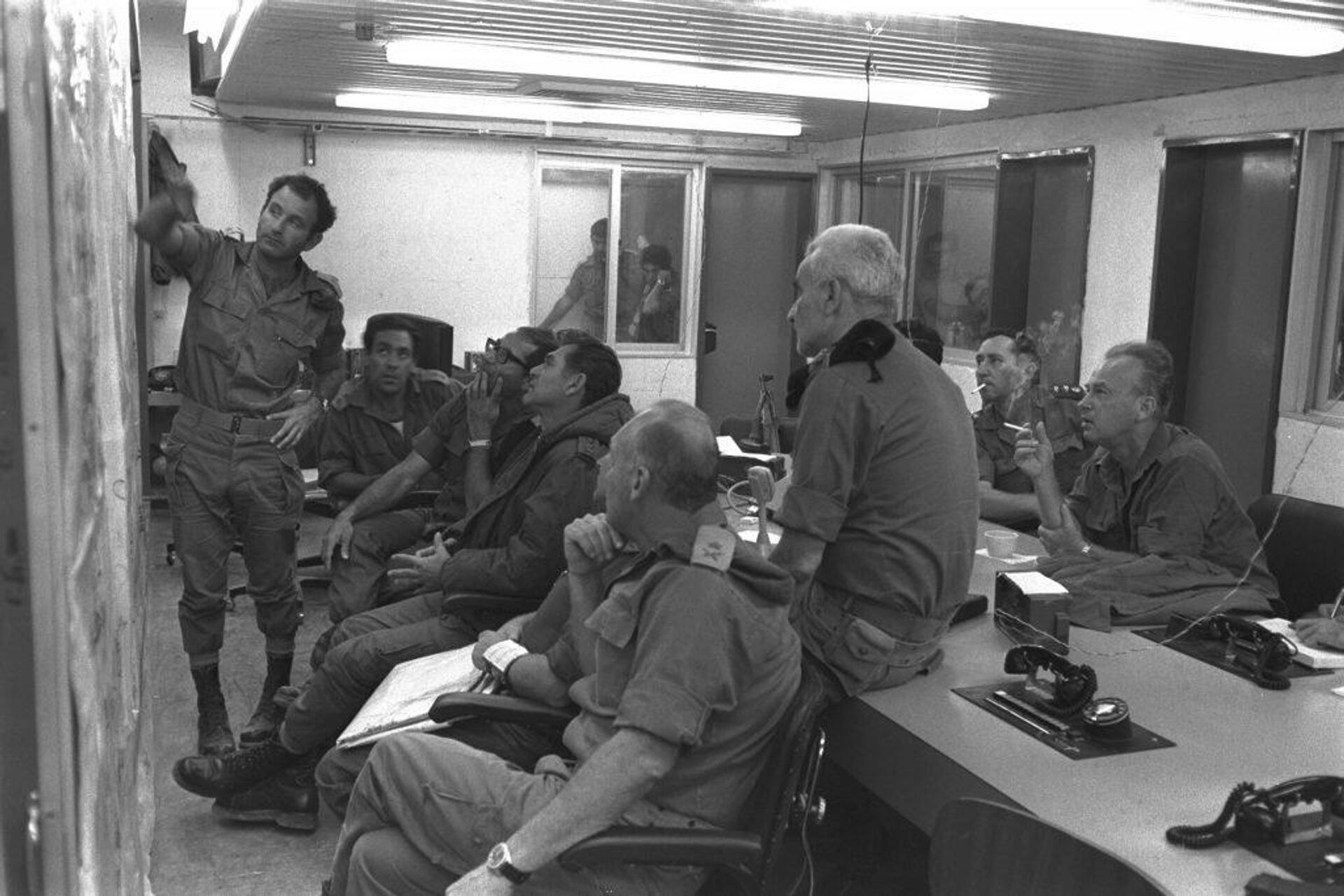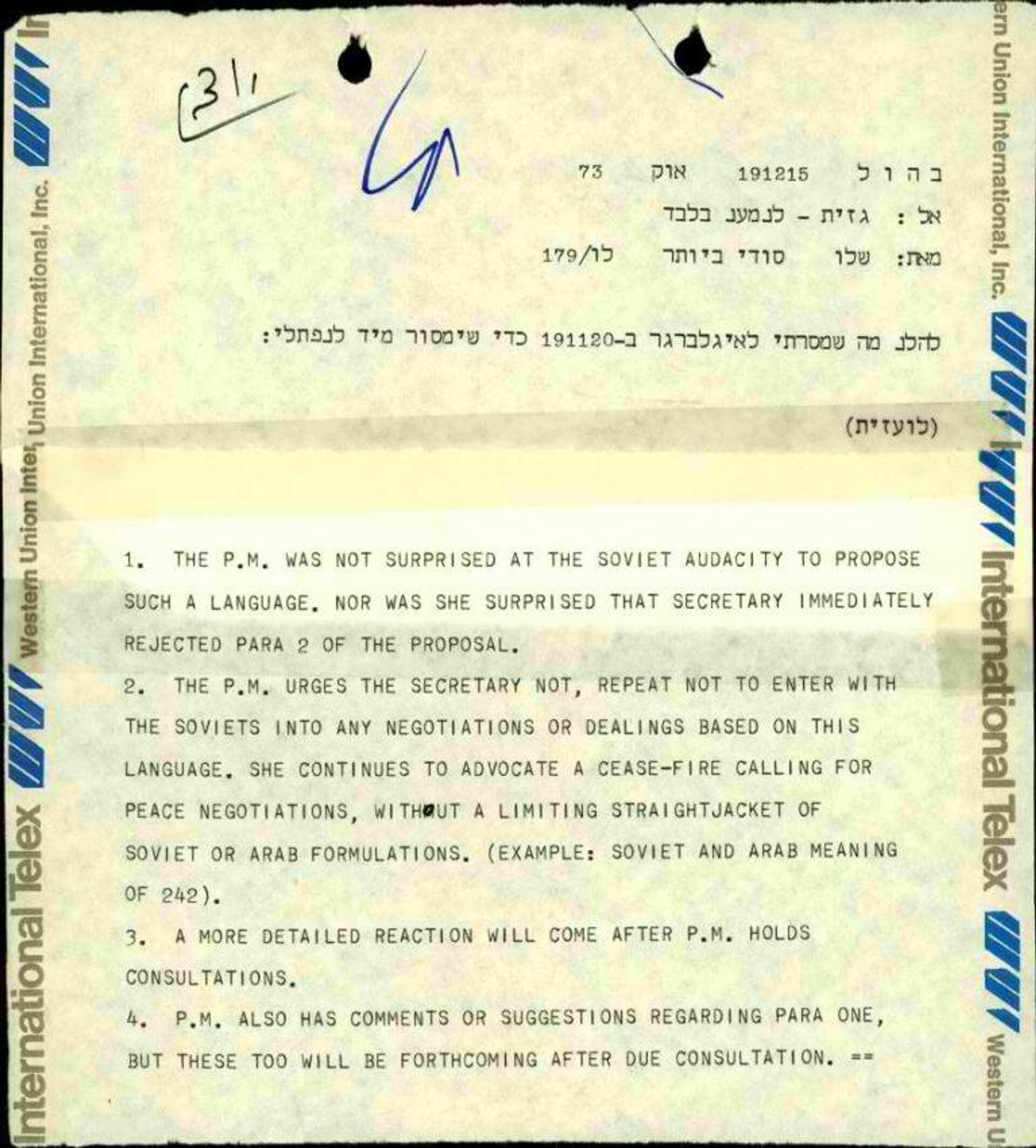On Anniversary of 1973 Surprise Attack, Israel Publishes Government Memos From Yom Kippur War
23:09 GMT 06.10.2021 (Updated: 20:20 GMT 19.10.2022)

© Israeli Government Press Office
Subscribe
On the anniversary of the Arab sneak attack on Israel that began the country’s most devastating military defeat, Jerusalem released 14 new internal documents revealing the chaos as Israeli leaders tried to make sense of the disaster's scope.
That anniversary is according to the Gregorian calendar used by the West, of course; in Israel, which follows the Hebrew calendar, the anniversary was two weeks ago, on the 10th of Tishrei.
‘We Never Faced So Grave a Danger’
It was perhaps one of the most unique war beginnings in history. Prepared for in the open by lulling the Israelis into a false sense of superiority, the Egyptian liberation of the Sinai Peninsula began not at dawn on October 6, 1973, but at 2 o’clock in the afternoon. Following a colossal artillery barrage and air blitz, Egyptian engineers snuck across the Suez Canal and accomplished the impossible: within an hour, they had blasted holes in the defensive Bar Lev sand berm wide enough to drive tanks through.
Their secret weapon? Not explosives or bulldozers, but high-powered water cannons - something the Israelis had never anticipated.

Egyptian military engineers employ water cannons to breach the Israeli sand wall on the east bank of the Suez Canal on October 6, 1973. Israel had expected it would take between 24 and 48 hours using explosives, but with the water cannons, the Egyptians breached the wall in less than 60 minutes.
At the other end of Israeli territory, Syria launched its own bombardment and invasion from the north, carefully planned and coordinated with the Egyptians. The element of surprise by both armies was almost complete, as the Israelis, who had defeated the Egyptians and Syrians as well as the Jordanians in 1967, believed their forces to be invincible and their enemies inept at warcraft.
In Israel, it was Yom Kippur, the Jewish day of atonement and holiest day of the year, during which many were fasting and at home or their synagogue. Towns and radios alike were silent, enabling the thunder of Syrian artillery to echo across much of the country.
The documents published by the Israel State Archives on Wednesday, the 48th anniversary of the attack, give a never-before-seen glimpse into the chaos that reigned during the following three weeks, as Israeli leadership struggled to understand and respond to the disaster. They include 14 transcripts of wartime government meetings, 21 political-security consultations with the war cabinet held by the prime minister, and 26 handwritten diary entries by Eli Mizrahi, the head of Prime Minister Golda Meir’s bureau.
“I did not sufficiently appreciate the enemy’s strength, the weight of his fighting force and I overestimated our forces and their ability to stand fast,” said Moshe Dayan, Israel’s then-defense minister who had overseen the lightning victory in 1967. “The Arabs are fighting much better than before.”
In another, Meir flatly stated, “I say this with full awareness of its significance – we never faced so grave a danger in 1948.”
Chaim Bar-Lev, who had designed the sand berm on the Suez but retired from his role as the IDF’s deputy chief of staff, was suddenly called back into service to save Israel’s collapsing position on the Sinai, where hundreds of Soviet-built Egyptian tanks were storming across the Suez on pontoon bridges assembled in record time and man-portable anti-air and anti-tank weapons were devastating an Israeli military still expecting to fight another 1960s-era war.
“On the first day of the war, we acted as if it were the seventh day of the Six Day War and used the same methods, and that was a mistake,” Bar-Lev said.

A consultation in the War Room of Southern Command, with Chief of Staff Elazar (third from the right), on his left OC Southern Command Gonen (Gorodish). Behind them: the ex-Chief of Staff Yitzhak Rabin, 8 October 1973. Photograph: Shlomo A
The documents reveal how divided Meir’s government was about how to respond to the crisis. While the prime minister had absolute faith in the IDF’s ability to fend off the Arab assault and actually sought to deter the US from putting a ceasefire before the UN Security Council, Dayan received a sobering perspective from his front-line generals and saw the situation collapsing before him.
They “will come to fight us for the land of Israel itself” and therefore “descent from the Golan is not a solution, since they will go on to the Hula valley … to conquer Israel, to finish off the Jews,” Dayan said in one ministerial meeting. By the end of the second day, the documents show he had already given up on the hope of forcing the Egyptians back across the Suez Canal.
Despite her professional confidence, in her diary, Meir despaired.
"They won't hunker down, they will attack. Move from one line to another and keep attacking," she said. "The little help we have from the global community will be gone, they will throw us to the dogs. They don't like Jews, let alone weak Jews."
However, the joint invasion didn’t quite pan out like she feared: after the IDF summoned its reserves, the counterattack was effective and pushed both armies back. Still, it wasn’t until October 14 that much-needed American aid began arriving, helping to replenish the IDF’s heavy material losses and allow them to continue their counterattack.
In Egypt and Syria, Soviet and Yugoslav supplies were also arriving in smaller numbers. Soon, not only had the Israelis entered southern Syria, they had re-crossed the Suez Canal at several points and were advancing on the Nile delta.
‘You Will Not Be Ashamed of Us’
At the height of Israeli desperation, then-US Secretary of State Henry Kissinger feared the Israelis might resort to nuclear weapons in order to stave off total defeat. The declassified documents don’t reflect that fear, of course, since Israel has never admitted to possessing nuclear weapons, but studies by the US Army’s Air War College have yielded valuable insights into what analysts have termed Israel’s “Samson Option.”

An M60 tank is unloaded from a US Air Force Lockheed C-5A Galaxy in Israel during "Operation Nickel Grass" in October 1973
© USAF
Still, the necessity of resupply had left the Israelis fearful they now looked weak and might lose American support in the future. Indeed, Kissinger had said Washington was “let down” by Tel Aviv.
“Tell him ‘You will not be ashamed of us,’” Dayan told Simcha Dinitz, Israel’s ambassador to Washington, to tell Kissinger on October 17. In fact, the documents seem to suggest that the Israeli push to accomplish as many military successes as possible in the final days of the war was pursued in part to impress the Americans and keep them from joining with the Soviets to push a ceasefire resolution at the UN.
“At the end of the day, the decisive factor is what you do in the field. If you succeed in destroying most of the Egyptian army, and I hope you do, then that fact has much more significance than one version or another” of the resolution, Kissinger told Dinitz on October 18. If Israel were to be handed a ceasefire resolution, Meir wanted it without a mention of UN Resolution 242, which had rejected Israel’s territorial seizures in the 1967 war as illegal.
“We see it as vital that this terrible war does not end with only a questionable ceasefire,” Shlomo Gazit, director of IDF intelligence, wrote to Dinitz on October 19. “Our aim is to enter negotiations and to achieve peace agreements. The mention of Resolution 242 will constitute a stumbling block. A simple formula about a ceasefire and a freeze [of the military situation], and a call for entering direct negotiations for peace is what is required now.”
By October 22, Resolution 338 had been introduced and adopted, calling for a ceasefire within 12 hours. When peace did not follow, Resolution 339 the following day urged it, and when fighting continued, Resolution 340 adopted on October 25 finally succeeded.
In the final days of the conflict, as the Egyptian Third Army neared annihilation and Israeli forces were situated just dozens of kilometers from both Cairo and Damascus, the danger of a Soviet intervention against the Israelis became so acute that avoiding it became Tel Aviv’s - and Washington’s - single greatest priority. The documents show the Americans felt it was inevitable that if the Soviet intervened, so must they.

The first page of a message sent to Israeli Foreign Minister Abba Eban by Prime Minister Golda Meir on October 18, 1973, urging that UNSC Resolution 242 be kept out of any ceasefire resolution the UNSC might issue in the coming days.
Avoidable Conflict?
The war was Israel’s costliest in terms of lives, with 2,656 killed, 7,251 wounded and 294 captured. On a visit to Washington days after the ceasefire, Meir compared the scale of loss to the US war in Vietnam, which had ended just months earlier.
"The people of Israel are characterized by two things - unmatched bravery and a complete inability to deal with a high number of casualties,” she said. "We are one big family, and every day will lose a close one and I see people's nerves being on edge."
A bitter note was struck during one of the final documents, when Meir realized that what the Egyptians had suggested - a withdrawal from the Sinai in exchange for a ceasefire - was what they were willing to accept. “We could have achieved that without a war,” she quipped.
Despite being invaded by the Israelis, the war helped salvage Egyptian President Anwar Sadat’s presidency, as it was seen as a successful revenge for the humiliation they had suffered in 1967. By 1978, Sadat had secured the return of the Sinai Peninsula and negotiated a permanent peace treaty with Israel. However, his abandoning of the Arab promise not to negotiate with the Israelis was a major factor in his assassination three years later by a member of Egyptian Islamic Jihad at a parade celebrating the October 6 military success.
In Syria, Israel retained control of the Golan Heights, which it recaptured before the war was over and continues to control to the present day. No peace treaty has ever been agreed to by the Israelis and Syrians.


